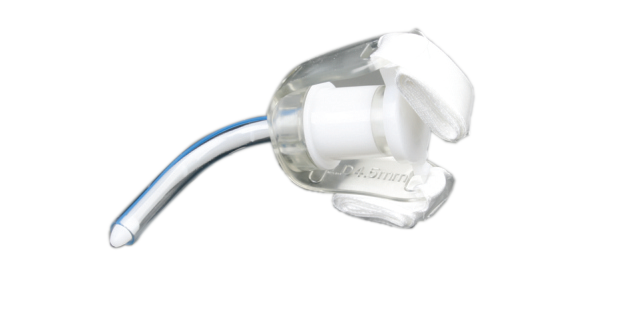
Tracheostomy tubes can be cuffed or uncuffed. Uncuffed tubes allow airway clearance but provide no protection from aspiration. A cuffless tracheostomy tube does not have a cuff (balloon like feature) at the end of the tube. If the patient does not require that the air from the ventilator is monitored and measured and is able to tolerate cuff deflation without respiratory distress, then a cuffless tracheostomy tube may be placed. Sometimes adult patients on mechanical ventilation are managed with cuffless tracheostomy tubes, but it is not common. Typically, patients are weaned from mechanical ventilation prior to placement of a cuffless tracheostomy tube. Pediatric and neonatal patients typically have cuffless tracheostomy tubes to prevent mucosal injury.
| Ref. No.: | Size: | Qty. Cs: |
|---|---|---|
| NMR100830 | 3.0 | 100 |
| NMR100835 | 3.5 | 100 |
| NMR100840 | 4.0 | 100 |
| NMR100845 | 4.5 | 100 |
| NMR100850 | 5.0 | 100 |
| NMR100855 | 5.5 | 100 |
| NMR100860 | 6.0 | 100 |
| NMR100865 | 6.5 | 100 |
| NMR100870 | 7.0 | 100 |
| NMR100875 | 7.5 | 100 |
| NMR100880 | 8.0 | 100 |
| NMR100885 | 8.5 | 100 |
| NMR100890 | 9.0 | 100 |
| NMR100895 | 9.5 | 100 |
| NMR1008100 | 10.0 | 100 |
A tracheostomy tube is a medical device that is inserted into the trachea (windpipe) to keep the airway open. It is used when there is a blockage of the airway that cannot be removed by conventional means.
A tracheostomy tube is a medical device that is inserted into the trachea (windpipe) to create an opening (tracheostomy). This opening allows air to enter the lungs and helps to keep the airway open. The tracheostomy tube is usually placed during surgery, but it can also be done in an emergency situation.
A tracheostomy is a medical procedure that involves making an incision in the neck and opening up a hole in the trachea, or windpipe. A tracheostomy tube is then inserted into this hole to help a person breathe.
There are different types of tracheostomy tubes, which are designed for different purposes. Some types of tracheostomy tubes are designed to be used in emergency situations, while others are meant for long-term use.
Emergency tracheostomy tubes are typically uncuffed and have a small diameter. They are designed to be inserted quickly and easily, without the need for anesthesia. These tubes are typically only used for a short period of time, until the person can be transferred to a facility where they can receive more comprehensive care.
Long-term tracheostomy tubes are typically larger in diameter and have a cuff that can be inflated. These tubes are usually inserted under general anesthesia and require more complex surgical techniques. These tubes are often used for people who cannot be safely intubated with a standard endotracheal tube.
When it comes to tracheostomy tubes, there are both pros and cons that need to be considered. On the plus side, tracheostomy tubes can be life-saving in emergency situations where a patient is struggling to breathe. They can also help to improve quality of life for patients who have long-term breathing difficulties. However, there are also some potential downsides to tracheostomy tubes, such as the risk of infection and complications from the surgery itself. Ultimately, the decision of whether or not to use a tracheostomy tube should be made on a case-by-case basis with input from the patient and their medical team.
A tracheostomy tube is a medical device that is inserted into the trachea (windpipe) to create an artificial airway. This may be necessary if the natural airway is obstructed or if the patient is unable to breathe on their own.
The tracheostomy tube is held in place by a cuff that inflated with air, which helps to keep the tube in place and prevent it from being dislodged. The tube also has a connector that allows for ventilation tubing to be attached, which will provide a way for the patient to be ventilated if they are unable to breathe on their own.
In order to insert the tracheostomy tube, the healthcare provider will make a small incision in the neck and insert the tube through this opening. Once the tube is in place, the cuff will be inflated and the connector will be attached to the ventilation tubing.
It is important to note that the tracheostomy tube should only be used by trained healthcare providers and should not be attempted by someone who is not trained in its use. If you have any questions about how to use a tracheostomy tube, please consult with your healthcare provider.
There are a few alternatives to tracheostomy tubes that can be used in emergency situations. One alternative is the laryngeal mask airway (LMA). LMAs are designed to establish and maintain an airway in seconds. They are made of soft, pliable materials and have a cuff that is inflated to create a seal around the laryngeal opening. LMAs can be inserted by paramedics or other trained medical personnel without the need for intubation. Another alternative is the supraglottic airway device (SAD), which is also designed to quickly establish an airway. SADs are made of rigid plastic and have a cuff that is inflated to create a seal around the laryngeal opening. SADs can be inserted by paramedics or other trained medical personnel without the need for intubation.